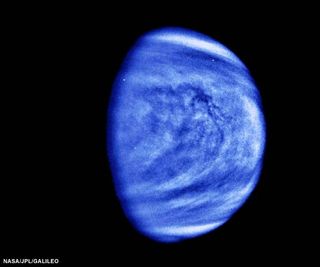The 6 Most Likely Places to Find Alien Life

Let's be upfront about this: We still don't have hard-nosed evidence for any life that's not of this Earth. That fact hasn't changed since the time of Aristotle.
But unlike that gifted Greek, a lot of folks today think proof of alien biology could grace the next news cycle. After all, astronomers have recently uncovered thousands of new planets; space agencies have relentlessly hurled hardware at dozens of solar system targets; and SETI (Search for Extraterrestrial Intelligence) scientists continue to build new equipment for tuning in ET's radio chatter.
Research budgets may be low, but expectations are high. Among the long list of locales where we might uncover life-as-we-don't-know-it, which are my favorites? In other words, where do I think we'll first find bits of self-organized chemistry that would forever – forever – be Exhibit A in our argument that life is a cosmic infection, rather than something extraordinarily rare or even unique?
Listed below are my top six picks for your consideration and possible contention. Note two matters of importance: (1) All my picks are members of our solar system, not because I believe that the rest of the cosmos isn't rife with life, but only because I suspect we'll uncover biology first where we can search for it in situ. In other words, my choices are practical. (2) Don't expect to learn that any of these habitats is festooned with life that creeps, crawls or can engage in conversation. These are all tough environments for any creature bigger than a microbe. But this list is about quickly discovering biology, not finding brainy buddies.
So here we go …
1) Enceladus: It's just a small moon of Saturn, but contrary to historical assumption it's not simply another pretty ice-covered rock. In 2005, NASA's Cassini spacecraft photographed geysers of frozen water spewing from cracks in Enceladus' southern hemisphere. The best guess is that reservoirs of liquid water lie beneath the frozen exterior, kept warm by gravitational interactions between this moon and other members of the Saturnian system. The necessities for life are there, and maybe Enceladans are as well. [Photos: Enceladus, Saturn's Cold, Bright Moon]
A major factor favoring this moon is that inhabitants could be easy to find. As my SETI Institute colleague Cynthia Phillips says, “Samples of whatever exists in those hidden aquifers are being continuously thrown into space, just waiting for us to grab.” No landers, no robot drills – proof for life on Enceladus may be there for the taking.
Get the Space.com Newsletter
Breaking space news, the latest updates on rocket launches, skywatching events and more!
2) Titan: Enceladus' hefty sibling is the only world in the solar system (besides Earth, of course) known to sport liquid lakes. Mind you, these are lakes of ethane and methane – liquid natural gas – endlessly topped up by a drizzle of hydrocarbon rain. But despite the odd ingredients and Titan's gelid temperatures (minus 290 Fahrenheit, or minus 179 Celsius), this is a world where chemistry's a happening enterprise. In addition, we know how to get robot landers onto its surface, because we've done it. In 2005 the Huygens probe set down on Titan's ice-balled landscape. A future probe – able to sail this moon's pungent lakes – might uncover a cache of the Titans.
3) Mars: Never voted off the island, Mars remains perennially popular for those hunting for otherworldly protoplasm. Particularly intriguing are the dark stripes that appear in the Martian summertime at Horowitz crater. These are likely to be salty meltwater only inches beneath Mars' dusty epidermis. A relatively simple probe could sample this muddy environment.
4) Europa: Many would grant this Jovian moon a higher rating than I have, since there's probably more liquid water here than in all of Earth's oceans. The downside is that Europa's vast and salty seas lie beneath roughly 10 miles of ice that's harder than tensor calculus. Not only would it be a labor of Hercules to get a probe beneath this icy armor, but Europa's oceans are darker than a cave – which means photosynthesis won't work. However, there could be something down there subsisting on geothermal heat or complex molecules from the surface.

6) Callisto and Ganymede: I've binned these two moons of Jupiter together, as I feel they're neck-and-neck candidates for biology. Like their more celebrated neighbor Europa, they may have buried, liquid oceans. However, in the case of these two satellite siblings, briny deeps would underlie at least 60 miles (100 km) of rock. Finding inhabitants here is a shovel-ready project for our grandkids.
These are my favorite places to look for extraterrestrial biology. I remind you that my preferences are no more than that: personal taste. The decision, as always in science, will be made by the data. If you wish to wager against me, alert your local bookie.
Seth Shostak is a senior astronomer at the SETI Institute in Mountain View, Calif. Follow SPACE.com for the latest in space science and exploration news on Twitter @Spacedotcom and on Facebook.
Join our Space Forums to keep talking space on the latest missions, night sky and more! And if you have a news tip, correction or comment, let us know at: community@space.com.

Seth Shostak is an astronomer at the SETI (Search for Extraterrestrial Intelligence) Institute in Mountain View, California, who places a high priority on communicating science to the public. In addition to his many academic papers, Seth has published hundreds of popular science articles, and not just for Space.com; he makes regular contributions to NBC News MACH, for example. Seth has also co-authored a college textbook on astrobiology and written three popular science books on SETI, including "Confessions of an Alien Hunter" (National Geographic, 2009). In addition, Seth ahosts the SETI Institute's weekly radio show, "Big Picture Science."
